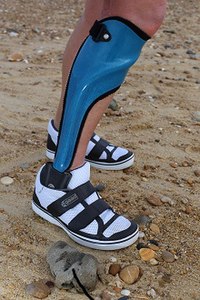
Photo from wikipedia
CONTEXT Slideboards are commonly used in exercise programs, but there is limited information about how they affect muscle activities during exercise. We aim to compare the activation levels of quadriceps… Click to show full abstract
CONTEXT Slideboards are commonly used in exercise programs, but there is limited information about how they affect muscle activities during exercise. We aim to compare the activation levels of quadriceps and hamstring muscles and hip- and knee-flexion angles during lunge and single-leg squat exercises between normal ground and slideboard in physically active individuals. DESIGN Cross-sectional study. METHODS Thirty healthy individuals (age: 23.83 [2.84] y, body mass index: 21.75 [1.72] kg/m2) were included in the study. Surface electromyography was used to measure vastus medialis, vastus lateralis, biceps femoris, and semitendinosus activation levels during reaching and returning phases of the forward, lateral, and back lunges and squats that were performed on the normal ground and slideboard. Exercises were performed at a slow pace (60 beats/min). Hip- and knee-flexion angles during the exercises were evaluated by using 2-dimensional motion analysis. Repeated measures of analysis of variance were used for statistical analysis. RESULTS Vastus medialis and vastus lateralis activation levels were greater during reaching and returning phases of the exercises on slideboard compared with normal ground (P < .05). However, semitendinosus and biceps femoris activity were greater only during the returning phase of the forward lunge (P < .001) and the returning phase of the back squat (P = .002, P = .009, respectively). Hip-to-knee flexion ratios were closer to 1 when the forward lunge (P < .001), back lunge (P = .004), and forward squat (P = .001) exercises were performed on a slideboard. CONCLUSION In exercise programs that target the quadriceps and hamstring muscles, slideboards can be effectively used in exercise progressions as they can increase muscle activity. Moreover, squat and lunge exercises on slideboard with a slow pace may also be helpful for improving the balance between hip- and knee-flexion angles.
Journal Title: Journal of sport rehabilitation
Year Published: 2023
Link to full text (if available)
Share on Social Media: Sign Up to like & get
recommendations!